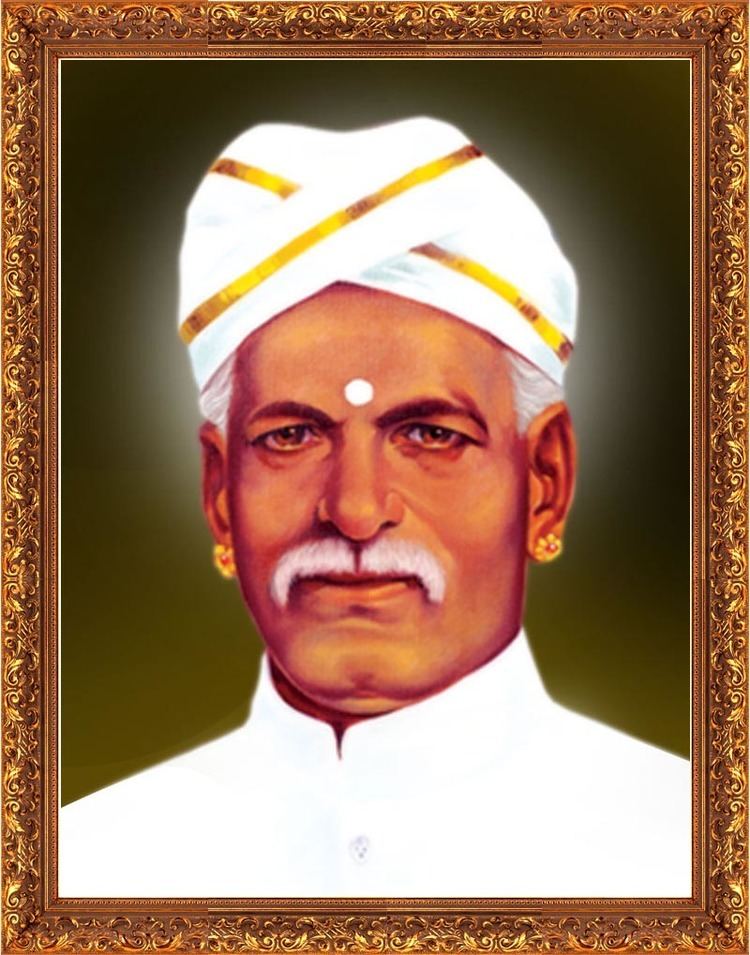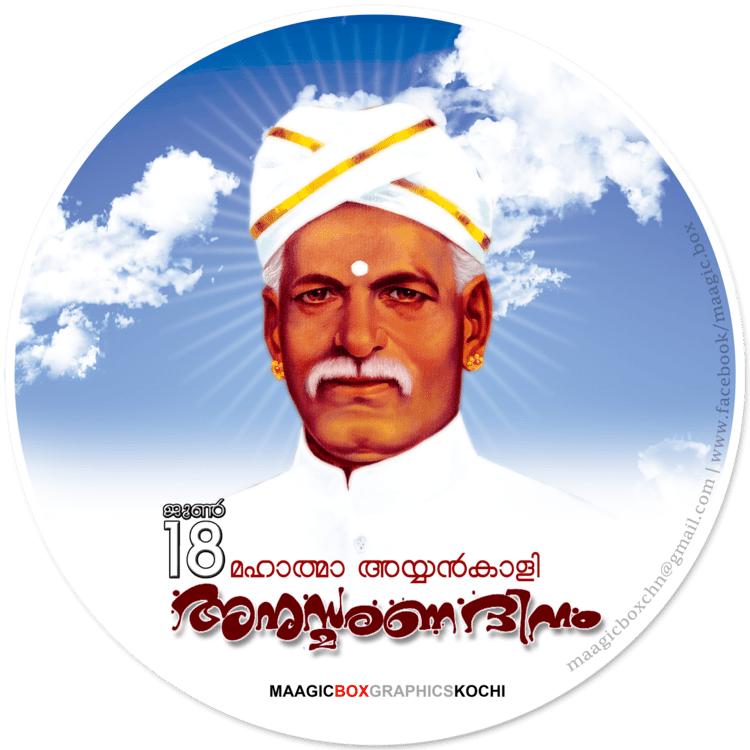Occupation Community activist Spouse(s) Chellamma | Name Ayyan Kali Children Seven | |
 | ||
Died June 18, 1941, Madras Presidency | ||
Ayyankali (also Ayyan Kali) (28 August 1863 – 1941) was a social reformer who worked for the advancement of those people in the princely state of Travancore, British India. His efforts influenced many changes that improved the social wellbeing of those people, who are today often referred to as Dalits.
Contents
- Mahathma ayyankali movie trailor
- Background
- Freedom of movement
- Education
- Representation
- Contribution and influence in society
- References

In November 1980, Indira Gandhi unveiled a statue of Ayyankali at Kowdiar square in Thiruvananthapuram.
Mahathma ayyankali movie trailor
Background
Ayyankali was born on 28 August 1863 in Perumkattuvila, Mukkola near Venganoor, Thiruvananthapuram, Travancore. He was the oldest of eight children born to Ayyan and Mala, who were members of the Pulayar community. Although the family were relatively well-off compared to other Pulayars, having been given 5 acres (2.0 ha) of land by a grateful landlord, the children were encouraged to adopt the customary occupation of agriculture.Ayyankali is a member of the assembly of Travancore, known as the Sree Moolam Popular Assembly (SMPA) or Praja Sabha Members of the Pulayar community generally were rural slaves at this time.
The region in which Ayyankali lived, which now forms a part of the state of Kerala, was particularly affected by social divisions during his lifetime and was described by Swami Vivekananda as a "mad house" of castes. Suffering from this social injustice caused Ayyankali to join with like-minded Pulayan friends. These young people gathered at the end of their workday to sing and dance to folk music that protested the situation. Some joined him in forming a group that challenged and threatened members of the upper castes whenever an opportunity arose, sometimes attacking them physically. His popularity earned him the names of Urpillai and Moothapullai.
Ayyankali married Chellamma in 1888. The couple had seven children.
Freedom of movement
In 1893, Ayyankali, dressed to provoke in clothing traditionally associated with the Nairs, defied the social conventions that applied to lower castes and untouchables by riding on a road in a bullock cart that he had bought. Both the act of purchase and that of travelling on a road that was traditionally the preserve of the upper castes amounted to a significant challenge. In a similar act of defiance, he entered the marketplace at Nedumangad. These protests, which have been described by Nisar and Kanadasamy as "laying claim to the public space", strengthened resolve among others from the oppressed communities of Travancore, leading to further protest acts elsewhere, such as in Kazhakkoottam. The outcome of continued protest marches, which sometimes turned violent and became known as Chaliyar riots, was that by 1900 the Pulayars had gained the right to use most roads in the state, although they were still barred from those that led to Hindu temples.
Later, in 1904, Ayyankali was inspired on hearing a speech given by the reformist Ayyavu Swamikal. This Hindu sanyasi of the Tamil Community had been preaching the need to break down caste divisions because he thought that doing so would limit the number of people who were converting from Hinduism to Christianity. A branch of Swamikal's Brahma Nishta Matam organisation was established in that year by Ayyankali and some friends in Venganoor. Ayyankali also drew inspiration from the activities of Narayana Guru, a contemporary social reformer from the Ezhava caste, although the two men differed in their philosophy and the means of turning it into reality. Narayana Guru had attempted to forge an alliance between the Ezhavas and untouchable communities such as the Pulayars but there had been violent opposition to the idea from his brethren and the Pulayars remained voiceless until the emergence of Ayyankali.
Education
Ayyankali also sought to improve access to education. Some Pulayars had access from around the mid-nineteenth century, mostly through the activities of the Colonial Missionary Society and London Missionary Society. Conversion to Christianity was a prerequisite for attendance at such schools, and there were cases where Pulayars offered to contribute to the cost of supplying teachers for them. However, Ayyankali, who was illiterate, believed that education should be available to all children and this meant that government schools should allow access to untouchables.
The government was already attempting to modernise its approach to social welfare in an attempt to impress on the British colonial administration that there was no need for the region to be annexed. Several public schools had been opened to untouchable communities after 1895 but the right to primary education was limited in scope. State funding of education became effective in 1904 but even after the government ordered schools to admit these untouchable people in 1907, local officials found ways to refuse it. In that year, helped by the experience gained from organising the Brahma Nishta Mattam, Ayyankali founded the Sadhu Jana Paripalana Sangham (SJPS) (Association for the Protection of the Poor) which campaigned for access to schools and raised funds to set up Pulayar-operated schools in the interim. This attracted support from both Hindus and Christians.
An attempt by Ayyankali to enrol a Pulayar girl in a government school led to violent acts perpetrated by upper castes against the community and eventually to the burning-down of the school building in the village of Ooruttambalam. His response was to organise what may have been the first strike action by agricultural workers in the region, who withdrew their labour from the fields that were owned by the upper castes until the government acceded to a complete removal of restrictions on education.
Ayyankali was also central to the success of the Pulayan challenge against the traditional stricture that prohibited female members of the community from clothing their upper body when in public. Caste Hindus had insisted that the custom was necessary to distinguish the lowly status of untouchable people but during the 19th century their belief had come under increasing attack from various untouchable groups and from Christian missionaries. The Channar revolt, through which the Nadar community were able to overturn the practice in so far as it affected themselves, had happened not long before Ayyankali's birth but the Pulayars remained affected by the discriminatory code until 1915-16.
He started a school at Venganoor.
Representation
Ayyankali later became a member of the assembly of Travancore, known as the Sree Moolam Popular Assembly (SMPA) or Praja Sabha.
Ayyankali died on 18 June 1941.
Contribution and influence in society
The historian P. Sanal Mohan has described Ayyankali as "the most important Dalit leader of modern Kerala". The anniversary of Ayyankali's birth has been celebrated by his descendants and by special interest groups.
Through the efforts of people such as K. K. Balakrishnan, P. K. Chathan Master and K. P. Madhavan, the Sri Ayyankali Trust was established. A life-size bronze statue of him, sculpted by Ezra David, travelled from Madras through the length of Kerala prior to being erected in Thiruvananthapuram.
